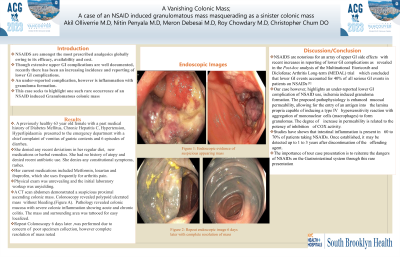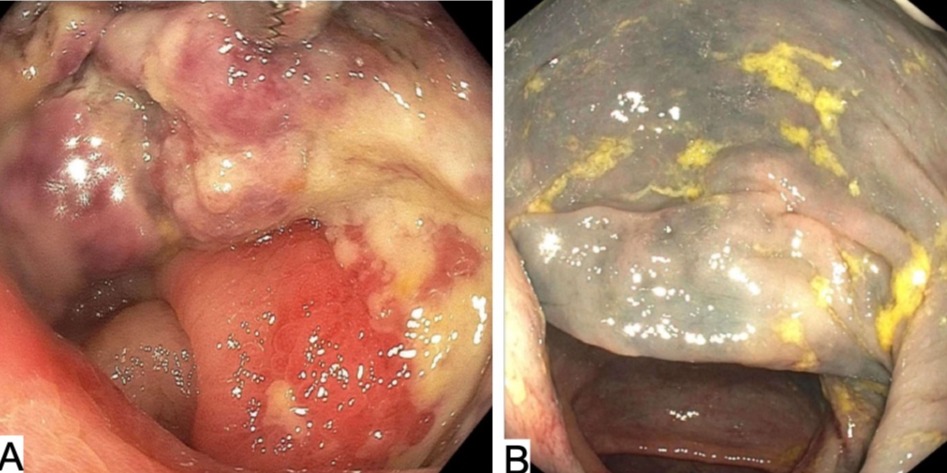Monday Poster Session
Category: Colon
P1633 - A Vanishing Colonic Mass: A Case of an NSAID-Induced Granulomatous Mass Masquerading as a Sinister Colonic Mass
Monday, October 23, 2023
10:30 AM - 4:15 PM PT
Location: Exhibit Hall

Has Audio

Akil Olliverrie, MBBS
South Brooklyn Health
Brooklyn, NY
Presenting Author(s)
Akil Olliverrie, MBBS1, Nitin Pendyala, MD1, Samiran Roy Chaudhury, MD1, Meron Debesai, MD1, Christopher Chum, DO2
1South Brooklyn Health, Brooklyn, NY; 2NYCHHC South Brooklyn Health, Brooklyn, NY
Introduction: NSAIDS are amongst the most prescribed analgesics globally owing to its efficacy. Though extensive upper GI complications are well documented, recently there has been an increasing incidence and reporting of NSAID induced lower Gastrointestinal complications. An under-reported complication however is inflammation with granuloma formation. This case seeks to highlight one such rare occurrence of an NSAID induced Granulomatous colonic mass.
Case Description/Methods: A 63 year old female with a past medical history of type 2 DM, HTN, HLD and chronic Hepatitis C who presented to the emergency department with a chief complaint of vomitus of gastric contents and 6 episodes of diarrhoea. She denied any dietary changes, no new medications or herbal remedies. She denies a history of atopy and recent antibiotic use. She is an active smoker with a 10 pack year history. Her current medications included Metformin, losartan and ibuprofen, which she uses frequently for arthritis pain. Physical exam was unrevealing and the initial laboratory workup was unyielding. A CT scan abdomen was performed, which demonstrated a proximal ascending colonic mass. GI was consulted and a colonoscopy found an infiltrative, polypoid ulcerated mass in the ascending colon (Figure A) partially circumferential was seen. Histology revealed colonic mucosa with severe colonic inflammation showing acute and chronic colitis. The affected areas were tattooed for easy identification on repeat colonoscopy. One week later on repeat colonoscopy, complete resolution of the mass was noted. ( Figure B).
Discussion: Our patient with prior negative colon cancer screening in the previous 3 years, presented with a granulomatous variant of ischemic colitis . The proposed pathophysiology is enhanced mucosal permeability, allowing for the entry of an antigen into the lamina propria capable of inducing a type IV hypersensitivity reaction with aggregation of mononuclear cells (macrophages) to form granulomas. The degree of increase in permeability is related to the potency of inhibition of COX activity. Studies have shown that intestinal inflammation is present in 60 to 70% of patients taking NSAIDs. Once established, it may be detected up to 1 to 3 years after discontinuation of the offending agent. The importance of our case presentation is to emphasize the dangers of NSAIDS on the Gastrointestinal system through a unique presentation of a suspicious colonic mass.

Disclosures:
Akil Olliverrie, MBBS1, Nitin Pendyala, MD1, Samiran Roy Chaudhury, MD1, Meron Debesai, MD1, Christopher Chum, DO2. P1633 - A Vanishing Colonic Mass: A Case of an NSAID-Induced Granulomatous Mass Masquerading as a Sinister Colonic Mass, ACG 2023 Annual Scientific Meeting Abstracts. Vancouver, BC, Canada: American College of Gastroenterology.
1South Brooklyn Health, Brooklyn, NY; 2NYCHHC South Brooklyn Health, Brooklyn, NY
Introduction: NSAIDS are amongst the most prescribed analgesics globally owing to its efficacy. Though extensive upper GI complications are well documented, recently there has been an increasing incidence and reporting of NSAID induced lower Gastrointestinal complications. An under-reported complication however is inflammation with granuloma formation. This case seeks to highlight one such rare occurrence of an NSAID induced Granulomatous colonic mass.
Case Description/Methods: A 63 year old female with a past medical history of type 2 DM, HTN, HLD and chronic Hepatitis C who presented to the emergency department with a chief complaint of vomitus of gastric contents and 6 episodes of diarrhoea. She denied any dietary changes, no new medications or herbal remedies. She denies a history of atopy and recent antibiotic use. She is an active smoker with a 10 pack year history. Her current medications included Metformin, losartan and ibuprofen, which she uses frequently for arthritis pain. Physical exam was unrevealing and the initial laboratory workup was unyielding. A CT scan abdomen was performed, which demonstrated a proximal ascending colonic mass. GI was consulted and a colonoscopy found an infiltrative, polypoid ulcerated mass in the ascending colon (Figure A) partially circumferential was seen. Histology revealed colonic mucosa with severe colonic inflammation showing acute and chronic colitis. The affected areas were tattooed for easy identification on repeat colonoscopy. One week later on repeat colonoscopy, complete resolution of the mass was noted. ( Figure B).
Discussion: Our patient with prior negative colon cancer screening in the previous 3 years, presented with a granulomatous variant of ischemic colitis . The proposed pathophysiology is enhanced mucosal permeability, allowing for the entry of an antigen into the lamina propria capable of inducing a type IV hypersensitivity reaction with aggregation of mononuclear cells (macrophages) to form granulomas. The degree of increase in permeability is related to the potency of inhibition of COX activity. Studies have shown that intestinal inflammation is present in 60 to 70% of patients taking NSAIDs. Once established, it may be detected up to 1 to 3 years after discontinuation of the offending agent. The importance of our case presentation is to emphasize the dangers of NSAIDS on the Gastrointestinal system through a unique presentation of a suspicious colonic mass.

Figure: Fig A demonstrating a granulomatous mass. Fig B showing complete resolution of mass on repeat colonoscopy
Disclosures:
Akil Olliverrie indicated no relevant financial relationships.
Nitin Pendyala indicated no relevant financial relationships.
Samiran Roy Chaudhury indicated no relevant financial relationships.
Meron Debesai indicated no relevant financial relationships.
Christopher Chum indicated no relevant financial relationships.
Akil Olliverrie, MBBS1, Nitin Pendyala, MD1, Samiran Roy Chaudhury, MD1, Meron Debesai, MD1, Christopher Chum, DO2. P1633 - A Vanishing Colonic Mass: A Case of an NSAID-Induced Granulomatous Mass Masquerading as a Sinister Colonic Mass, ACG 2023 Annual Scientific Meeting Abstracts. Vancouver, BC, Canada: American College of Gastroenterology.
